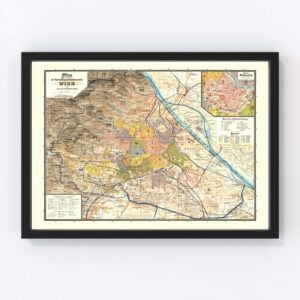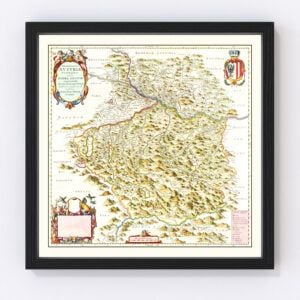Old Maps of Austria
Take a look into our collection of Old Maps of Austria.
Austria is a landlocked country that occupies a population of 9 million people, with a total area of 83,879 square kilometers (or 32,386 square miles). Since it is a landlocked country, it is bordered by numerous countries, such as Germany, the Czech Republic, Slovakia, Hungary, Slovenia, and Italy. The name “Austria” originates from the German word “east”. Austria is consistently ranked one of the richest countries to live in due to the high GDP per capita, and was also ranked 18th best on the Human Development Index.
Because of its location in the Alps, Austria is a country that is majority made up of mountains. Only about a quarter of the entire area can be considered flatland, and only 32% of the country sits below 1,640 feet. Because of this, the climate in Austria is cool and temperate. There are very cool winters, as well as hot and humid summers. However, the summers are typically cooler near mountains than in lower altitudes.Austria is made up of nine federal states and they are as follows: Burgenland, Carinthia, Lower Austria, Salzburg, Styria. Tyrol, Upper Austria, Vienna, and Vorarlberg. The most populated out of these nine is Vienna, which is also the capital of Austria. In fact, Vienna is by far the most populated city located in Austria, with a population of around 1.9 million individuals. To compare that, the second most populated city is Graz, with around 270,000 individuals.
Currently, Austria is a federal representative democratic republic, and has been since 1920. The current president of Austria is Alexander Van der Bellen. Austria has a very politically rich background when it comes to its history. In 1995, Austria joined NATO’s (North Atlantic Treaty Organization) Partnership for Peace, and also participated in peacekeeping missions. Along with this, Austria also signed the UN’s Nuclear War Ban Treaty, which is a treaty that all other members of NATO opposed.
Due to a very highly industrialized economy and well-developed market, Austria has continuously been able to rank high in GDP per capita. Since joining the European Union, Austria has opened up numerous trade opportunities with surrounding countries as well as giving foreign investors interest into the Austrian market.
Throughout history, Austria has been a powerhouse for music, specifically classical music. In fact, Vienna was once considered the European capital for classical music. Some of the most famous composers in history were born in Austria, such as Wolfgang Amadeus Mozart, Johann Strauss Jr. and Sr., Joseph and Michael Haydn, and Franz Liszt. So many were drawn to Vienna for music due to the 18th and 19th century patronages of the Habsburgs, which was once the most prominent royal dynasty within Austria.
And finally, some fun facts about Austria:
The Austrian flag is one of the oldest flags in the world, with its first recorded use being in 1230.
Austria is home to the tallest waterfalls in Europe, known by the name “Krimmler Wasserfälle”.
Until 1955, Austria was separated into numerous zones that different countries had control over.

















Old Maps of Austria
Take a look into our collection of Old Maps of Austria.
Austria is a landlocked country that occupies a population of 9 million people, with a total area of 83,879 square kilometers (or 32,386 square miles). Since it is a landlocked country, it is bordered by numerous countries, such as Germany, the Czech Republic, Slovakia, Hungary, Slovenia, and Italy. The name “Austria” originates from the German word “east”. Austria is consistently ranked one of the richest countries to live in due to the high GDP per capita, and was also ranked 18th best on the Human Development Index.
Because of its location in the Alps, Austria is a country that is majority made up of mountains. Only about a quarter of the entire area can be considered flatland, and only 32% of the country sits below 1,640 feet. Because of this, the climate in Austria is cool and temperate. There are very cool winters, as well as hot and humid summers. However, the summers are typically cooler near mountains than in lower altitudes.Austria is made up of nine federal states and they are as follows: Burgenland, Carinthia, Lower Austria, Salzburg, Styria. Tyrol, Upper Austria, Vienna, and Vorarlberg. The most populated out of these nine is Vienna, which is also the capital of Austria. In fact, Vienna is by far the most populated city located in Austria, with a population of around 1.9 million individuals. To compare that, the second most populated city is Graz, with around 270,000 individuals.
Currently, Austria is a federal representative democratic republic, and has been since 1920. The current president of Austria is Alexander Van der Bellen. Austria has a very politically rich background when it comes to its history. In 1995, Austria joined NATO’s (North Atlantic Treaty Organization) Partnership for Peace, and also participated in peacekeeping missions. Along with this, Austria also signed the UN’s Nuclear War Ban Treaty, which is a treaty that all other members of NATO opposed.
Due to a very highly industrialized economy and well-developed market, Austria has continuously been able to rank high in GDP per capita. Since joining the European Union, Austria has opened up numerous trade opportunities with surrounding countries as well as giving foreign investors interest into the Austrian market.
Throughout history, Austria has been a powerhouse for music, specifically classical music. In fact, Vienna was once considered the European capital for classical music. Some of the most famous composers in history were born in Austria, such as Wolfgang Amadeus Mozart, Johann Strauss Jr. and Sr., Joseph and Michael Haydn, and Franz Liszt. So many were drawn to Vienna for music due to the 18th and 19th century patronages of the Habsburgs, which was once the most prominent royal dynasty within Austria.
And finally, some fun facts about Austria:
The Austrian flag is one of the oldest flags in the world, with its first recorded use being in 1230.
Austria is home to the tallest waterfalls in Europe, known by the name “Krimmler Wasserfälle”.
Until 1955, Austria was separated into numerous zones that different countries had control over.
